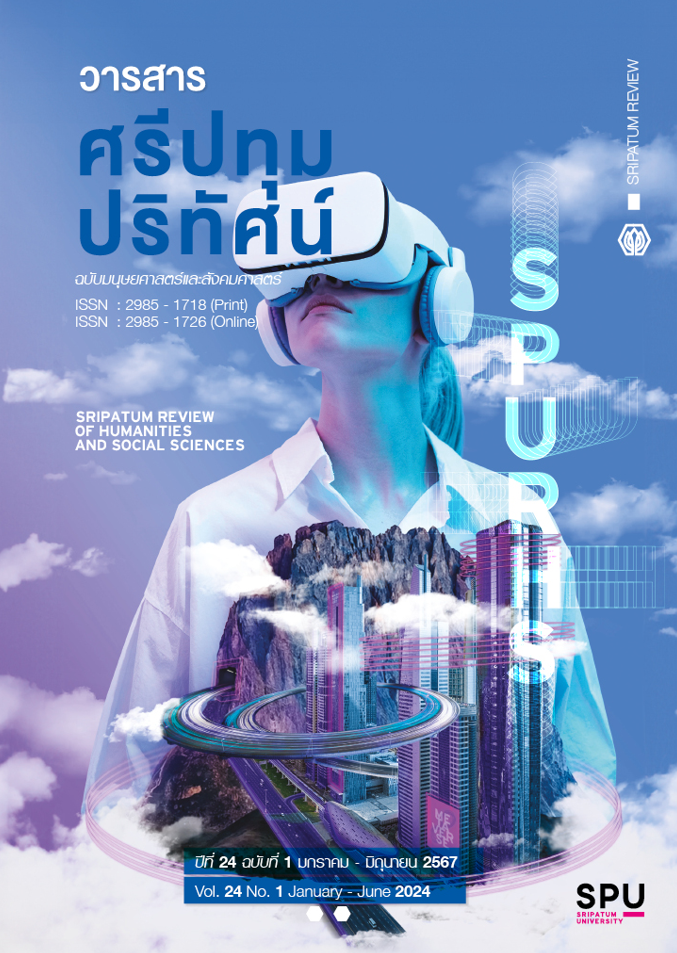Development Process of Brand Identity and Community Participatory Packaging of Ban Sao Luang Weaving Group Community Enterprise, Bo Suak Sub-district, Mueang District, Nan Province.
Main Article Content
Abstract
Research on The process of developing brand identity and community packaging with participation of the Ban Sao Luang Weaving Group community enterprise, Bo Suak Subdistrict, Mueang District, Nan Province, has two important objectives: 1) to study community identity from social and cultural capital. Participate in the community enterprise group, Ban Sao Luang Community Weaving Group, and 2) To develop brand design and identity packaging through participatory processes participatory identity of the Ban Sao Luang community weaving enterprise group It is participatory action research. (Participatory Action Research: PAR) collects data through hands-on activities. group chat and brainstorming meeting From the committee and community enterprise members Including 45 representatives of local government agencies, analyzing content data and using T-Test statistics.
From the study results it was found that The community enterprise of the Ban Sao Luang Community Weaving Group has a context and identity of Social and cultural capital through the “Bor Suak pattern” (a pattern resembling an owl in a lotus petal frame with a cut tip resembling an epaulette) that was modeled after the pattern on the mouth of an ancient jar that was endemic to Nan in the past. Created as the brand "Int Kham Saeng", meaning the prosperity of ancient hand-woven fabric. which inspired the 800 year old jar into the fabric Emphasis on using the natural colors of the Nonsi tree. As for the process of designing branding and community identity packaging, it was found that Collaborative decision-making takes place in selecting patterns and packaging styles that convey the distinctiveness of the group. As well as being able to reflect the weaving lifestyle in the Ban Sao Luang community. Three types of prototypes were obtained for commercial use: 1) brand tags, 2) brand stickers, and 3) packaging. In terms of cost, it was found that There is no impact on the original cost when compared. And the satisfaction evaluation results comparing the original brand and product with the new brand and product were significantly different at the 0.5 level (t=3.64). There is a low level of satisfaction with the old brand and product format (x̅=2.55) and a high level of satisfaction with the new brand and product format (x̅=4.29).
Article Details

This work is licensed under a Creative Commons Attribution-NonCommercial-NoDerivatives 4.0 International License.
1. กองบรรณาธิการสงวนสิทธิ์ในการพิจารณาและตัดสินการตีพิมพ์บทความในวารสาร
2. บทความทุกเรื่องจะได้รับการตรวจสอบทางวิชาการโดยผู้ทรงคุณวุฒิ แต่ข้อความและเนื้อหาในบทความที่ตีพิมพ์เป็นความรับผิดชอบของผู้เขียนแต่เพียงผู้เดียว มิใช่ความคิดเห็นและความรับผิดชอบของมหาวิทยาลัยศรีปทุม
3. การคัดลอกอ้างอิงต้องดำเนินการตามการปฏิบัติในหมู่นักวิชาการโดยทั่วไป และสอดคล้องกับกฎหมายที่เกี่ยวข้อง
References
Abras, C. et.al. (2004). “User-Centered Design”. Encyclopedia of Human-Computer Interaction.
Bunsong Udomkijkoson. (2018). Brand design and packaging of "Ban Sae" Bang Kradi community. Bang Khun Thian District Bangkok. (Research report). Bangkok: Kasem Bundit University.
Chanyanan Somthawinphongsai et al. (2022). Cultural capital management for brand design of community enterprise groups, Phu Khao Thong Subdistrict, Phra Nakhon Si Ayutthaya Province. Ratchaphak Journal, 16(46). 465-476.
Cheuypoung, T. (2020). Lifestyle Fashion Brand Identity for Masstige by Using the Cultural Capital of Thai Song Dam, Phetchaburi Province. Suan Sunandha Academic & Research Review, 13(1), 31-42.
Chumket, J. (2017). Product Development from Local Wisdom for Enhancement of Sustainable Community Management of Thai Muslim Community, Cha-am District, Phetchaburi Province. Faculty of Management Science, Silpakorn University.
Gaffney, G. (1999). Participatory Design Workshops. Usability Techniques series.
Karat, J. (1997). “Evolving the Scope of User-Centered Design”. Communucation of the ACM, 40(7). 33-38.
Korakot Pangjai. (2019). Community enterprise representative of Ban Sao Luang Community Weaving Group. (12 March 2019). Interview. Department of Cultural Promotion Ministry of Culture. Project to develop the cultural heritage of Thai fabrics to the world. TAPROOT THAI TEXTILES. Bangkok: M.P.P.
Natthamon Teerakul, Aree Wiboonpong, and Songsak Sribunjit. (2005). The self-reliance process of the agricultural community towards OVOP and lessons learned for OTOP Thailand. Annual Academic Conference 2005.
Office of the National Economic and Social Development Council. (2017). National Economic and Social Development Plan No. 12 (2017–2021). Retrieved on 20 April 2021, from https://www.nesdc.go.th/main.php?filename=index
Phasakorn Nantapanich. (2017). Creating shared value. and cooperation between farmers, academics, and the business sector: lessons learned from the project to produce quality dried chilies in Ammuang Sib Ubon Ratchathani Province. Kaen Kaset Journal 45 Special Issue 1. 2017. 553-561.
Pun Kongcharoenkiat and Somporn Kongcharoenkiat. (1999). Subdivided packaging and food packaging: Asia Pacific Food Industry Magazine.
Sanoff, H. (2000). Community participation methods in design and planning. Wiley, New York. 320 p.
Surapa Wongsuwan. (2019). The design process of Japanese One Community One Product (OVOP) packaging art from a Thai perspective. Academic Journal of Art and Architecture Naresuan University. Retrieved on 24 July 2019, from https://so01.tcithaijo.org/index.php/ajnu/article/ view/AJNU10-2-18/159430


